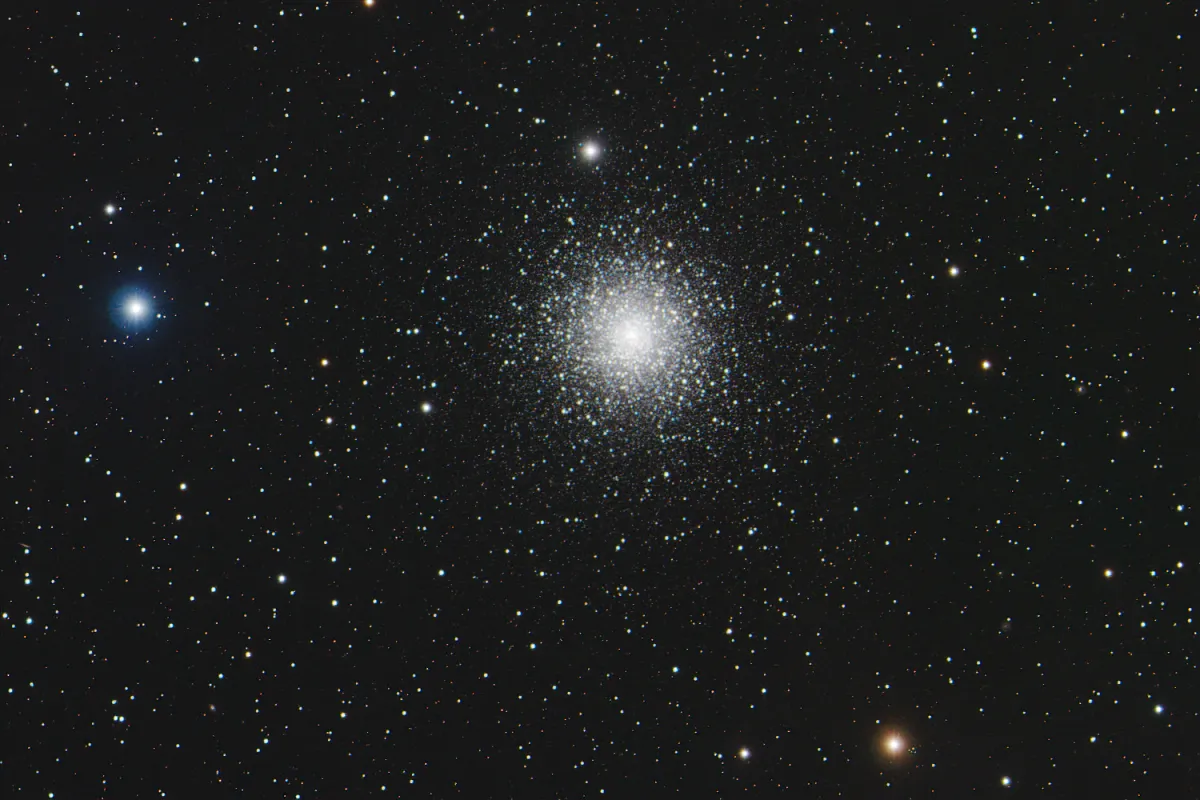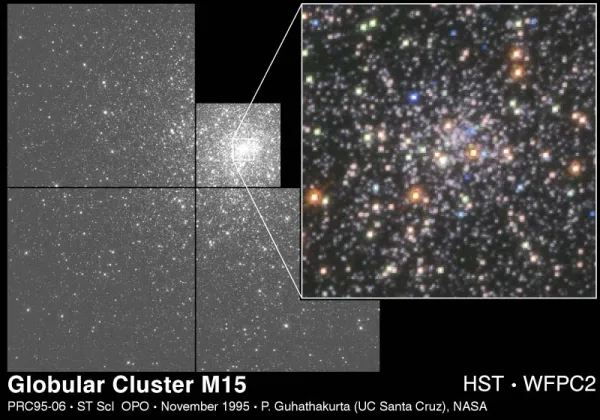Globular Cluster Messier 15 & Planetary Nebula Pease 1


History
M 15 is a beautiful globular cluster and was discovered by Maraldi in September 1746 while searching for the de Cheseaux comet that year. He described it as «a fairly bright nebula star composed of several stars». On 3 June 1764 the cluster was independently found again by Charles Messier. He described it as follows: «Starless nebula, located between the head of Pegasus and that of the Little Horse; it is round, with a bright center, and its position was determined by comparing it to δ of the Little Horse. Mr. Maraldi, in the Memoirs of the Academy of 1746, speaks of this nebula: ‹I observed,› he said, ‹between the star ε of Pegasus and β of the Little Horse, a fairly bright nebulous star, which is composed of several stars; its right ascension is 319° 27′ 6″, and its northern declination is 11° 2′ 22″.›» [281]
About two decades later Sir William Herschel observed the objects found Messier and recognized the true nature of many of these «nebulae». He wrote: «The excellent collection of nebulae and clusters of stars which has lately been given in the Connoissance des Temps for 1783 and 1784, leads me next to a subject which, indeed, must open a view of the heavens. As soon as the first of these volumes came to my hands, I applied my former 20-feet reflector of 12 inches aperture to them; and saw, with the greatest pleasure, that most of the nebulae, which I had an opportunity of examining in proper situations, yielded to the force of light and power, and were resolved into stars. For instance the 2d, 5, 6, 10, 12, 13, 14, 15, 16, 19, 22, 24, 28, 30, 31, 37, 51, 52, 53, 55, 56, 62, 65, 66, 67, 71, 72, 74, 92, all which are said to be nebulae without stars, have either plainly appeared to be noting but stars, or at least to contain stars, and to shew every other indication of consisting of them entirely.» [27]
Physical Properties
What is remarkable about this globular cluster is the intense brilliance of the central region, where countless stars seem to be crowded together. The central region is not exactly round, but slightly elliptical in the direction of PA 35° and measures about 20 arc seconds in diameter. Various ill-defined dark spots can be seen on long-exposure images, similar to those in M 13. M 15 probably shows the densest central region of all globular clusters in our galaxy.

Careful analysis of the star distribution suggests that the stars converged towards the centre of M 15 at some point in the past. This collapse is likely to have started only a few million years ago - a very brief moment when you consider the old age of the cluster of around 12 billion years. It is believed that a massive black hole is responsible for this, because M 15 is also a source of X-rays.
The integrated spectral type of the globular cluster is about F3 and the total luminosity is about 200'000 times that of the sun. M 15 contains around 30'000 stars, mainly red giants with an absolute magnitude of -2 mag. A large number of variables, mainly of the RR Lyrae type, were discovered in M15. The distance from M 15 is estimated to be 32'000 to 50'000 light years and it is approaching us at a speed of around 110 km/s. With an average value of these distances, M 15 has a diameter of about 130 light years. [4]
The inset Fig. 3 measures around 1.6 light years in edge length and shows the core region. It is a triple false colour composite of images from ultraviolet, blue and visible light, so that the colour of the stars roughly also reflects their surface temperature: hot stars appear blue and cooler ones appear red-orange. [168] [168]
| Designation | NGC 7078 |
| Type | GCL (IV) |
| Right Ascension (J2000.0) | 21h 29m 58.3s |
| Declination (J2000.0) | +12° 10' 03" |
| Diameter | 18 arcmin |
| Visual magnitude | 6.3 mag |
| Metric Distance | 10.400 kpc |
| Dreyer Description | !, globular, vB, vL, iR, vsmbM, rrr, st vS |
| Identification, Remarks | h 2120; GC 4670; M 15; GCL 120 |
Planetary Nebula Pease 1

An amazing and rare feature of the globular cluster M 15 is the presence of the small planetary nebula Pease 1, which is located on the northeast side of the cluster. The PN measures about an arc second in diameter and was first discovered by FG Pease in 1927 on photographic plates of the 100 inch telescope on Mt. Wilson. The emission spectrum of the PN is fairly continuous with a few bright lines. Measurements of the radial velocity of the nebula and that of the Haufens actually confirmed that they belonged to M 15.
| Designations | PN G065.0-27.3: Ps 1, PK 65-27.1, ARO 111, Ku 648, VV 265, VV' 550 |
| Right Ascension (J2000.0) | 21h 29m 59s |
| Declination (J2000.0) | +12° 10' 26" |
| Dimensions | 1." (optical), 3." (radio) |
| Distance | 13.5 kpc |
| Radial Velocity | -140.6 ± 16.9 km/s |
| C-Star Designations | AG82 426bis |
| C-Star Magnitude | B: 14.76, V: 14.95 |
| Discoverer | PEASE 1928 |
Finder Chart for M 15
The globular cluster Messier 15 lies in front of the nostrils of the winged horse Pegasus. If you extend the line of the stars Biham (θ Pegasi) and Enif (ε Pegasi), which are seven degrees apart from each other, by a further four degrees in the north-west direction, you come across the globular cluster.
Finder Chart for Pease 1
If you want to find this planetary nebula, you need a dark sky, calm air, a telescope with at least 300 mm aperture (tracking is an advantage), an O-III filter and a lot of patience. Pease 1 is about one arc second in diameter!


The planetary nebula Pease 1 is located near the centre of the globular cluster M 15. The first location map (Figure 6) provides an overview. The distance of the 7.56 mag star HD 204712 to the core of M 15 is 6 '41 ". The trapezoid of four stars serves as the starting point. It is clockwise, roughly at right angles to the connecting line HD 204712 - M 15. As soon as you reach the trapezoid you can use the map on the right (Figure 7) to go star-hopping over the stars A, B, C, D and E to a small cluster of stars. Pease 1 lies slightly in a north-westerly direction found, the position can be verified using an O-III filter. [217]
Visual Observation
317 mm Aperture: Pease in M15 / Planetary nebula in globular clusters. Extremely difficult, area identified with a finder chart and without OIII, at the border to the light central part, lightest point identified several times with OIII as Pease 1. Eyepiece: TV-Nagler zoom 6mm-3mm, 250x-500x, 0.22° -0.11°, filter: without and with OIII, 12.5" obsession by Pierre, observation repeated and confirmed. — 8.10.2007, Eduard von Bergen, Embergeralm.
400 mm Aperture: The PN in M 15 can be easily identified using the finder chart and can be easily recognized as a washed-out nebula without a filter. — Taurus T400 f/4.5 Dobsonian, 4. 9. 2021, Bernd Nies, Gurnigel.
508 mm Aperture: Pease in M15 with 20" Obsession by Wilfried recognizable as a blurred area of two star widths. — 8.10.2007, Eduard von Bergen, Embergeralm.
762 mm Aperture: The position of Pease 1 can be easily determined using the finder chart. Assuming calm air, the PN is clearly recognizable as a small, blurred, faint spot larger than surrounding stars at a correspondingly high magnification without a filter. With the O-III filter, the stars around the globular cluster become significantly weaker. The PN retains roughly the same brightness. We did not agree on whether it was better or less recognizable. I found the sight of the PN under all the twinkling stars of the globular cluster without an O-III filter more impressive. — 13. 8. 2021 Bernd Nies, Eduard von Bergen, 30" Slipstream Dobsonian, Hasliberg.
